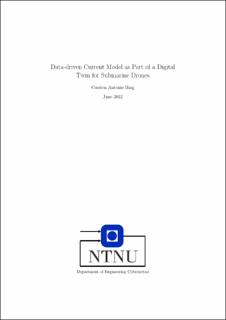| dc.contributor.advisor | Alver, Morten Omholt | |
| dc.contributor.advisor | Halvorsen, Daniel Ørnes | |
| dc.contributor.advisor | Michelsen, Finn Are | |
| dc.contributor.author | Bing, Carsten Antonio | |
| dc.date.accessioned | 2022-10-12T17:20:38Z | |
| dc.date.available | 2022-10-12T17:20:38Z | |
| dc.date.issued | 2022 | |
| dc.identifier | no.ntnu:inspera:102231297:64507564 | |
| dc.identifier.uri | https://hdl.handle.net/11250/3025733 | |
| dc.description.abstract | Undervannsdroner har historisk sett ikke vært i stand til å bruke fulle havsimuleringer på grunn av at de krever omfattende prosessorkraft. Dette prosjektet utvikler en enkel datadrevet havmodell som simulerer data fra SINTEFs havmodell SINMOD ved hjelp av Radial Basis Functions (RBFs) og en Gaussian Kernel. RBF-ene i dette prosjektet kombinerer sinus og cosinus for å modellere tidevannsdynamikk og Laguerre-polynomer for å modellere ikke-tidevannsdynamikk. Initiell parameterisering og optimalisering gjennomføres i Python ved å bruke programvarepakken MOSEK Optimization Suite. Havmodellen skal kunne ta målinger på punkter i rutenettet og justere sine parametere gjennom et Kalman-filter. Målet med modellen, ifølge SINTEF, er en 2,5m horisontal landingsnøyaktighet på 1000m dybde.
Testing viste at de valgte RBF-ene kunne følge strømningshastigheten ved RBF-punktene nøyaktig og for hele feltet med en andre optimalisering. Et Kalman-filter ble implementert for å justere for innkommende målinger.
Tre casestudier ble utforsket; én statisk måling, når antall målinger overskrider RBF-punkter og et realistisk dynamisk dronescenario . Disse viste at avstanden fra måling til RBF-punkt var proporsjonal med endringen. Resultatene fra disse fremhevet viktigheten av målepunkt posisjon. Det var et problem med konvergens for casene, antatt å være forårsaket av tilgjengelig prosessorkraft eller oppsett av reparameteriseringsproblemet. Den dynamiske casen viste hvordan punkter nærmere måledronene var mer utsatt for justering enn de som var lenger unna.
Analysen fullført i denne artikkelen legger grunnlaget for havstrømnings-prediksjon i undervannsdroner. For at metoden skal kunne brukes effektivt, må problemer med prognoser og konvergens imidlertid løses. | |
| dc.description.abstract | Underwater drones have historically not been able to use full ocean simulations due to requiring extensive processing power. This project develops a cheap data-driven ocean model simulating data from SINTEF's ocean model SINMOD using Radial Basis Functions (RBFs) and a Gaussian Kernel. The RBFs in this project combines sines and cosines to model tidal dynamics and Laguerre polynomials to model non-tidal dynamics. Initial parameterization and reparameterization are completed in Python using the MOSEK Optimization Suite software package. The ocean model should be able to take measurements at points in the grid and adjust its parameters through a Kalman filter. The objective of the model, according to SINTEF, is a 2.5m horizontal landing accuracy at 1000m depth.
Testing showed that the RBFs chosen could follow the flow velocity at the RBF points accurately and for the whole field with a second optimization. A Kalman filter was implemented to adjust for incoming measurements.
Three case studies were explored; one static measurement, measurements exceeding RBF points, and a realistic dynamic drone scenario. These showed that distance from measurement to RBF point was proportional to the change. The results from these highlighted the importance of measurement position. There was an issue of convergence for the cases, speculated to be caused by available processing power or setup of the reparameterization problem. The dynamic case showed how points closer to the measurement drones were more prone to adjustment than those further away.
The analysis completed in this paper lays the groundwork for current prediction in underwater drones. However, for the method to be used efficiently, issues of forecasting and convergence will need to be resolved. | |
| dc.language | eng | |
| dc.publisher | NTNU | |
| dc.title | Data-driven Current Model as Part of a Digital Twin for Submarine Drones | |
| dc.type | Master thesis | |
